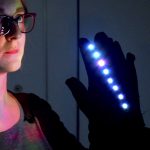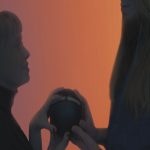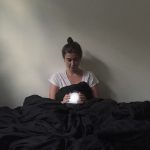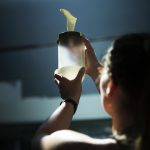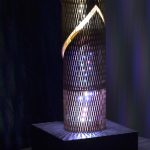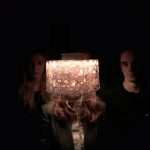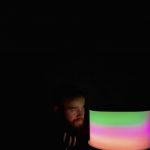Exhibition ‘Lights, Body, and Interaction’
Alongside stories of successes, failures, and reflection, 12 student groups show their lamp prototypes designed for tangible, interactive experiences with bodies, code, electronics, and materials. Results of the 2nd sem. DDK course ‘Designing Interactive Artefacts’.
Course teachers: Laurens Boer, Dag Svanæs, and Harvey Bewley
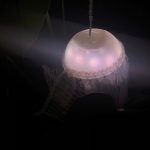 I2SEA
I2SEA
F. Westberg, A. Talli & M. Marckmann
This anthropomorphic creature demands nothing from you but your attention. Moulded by the hands of three crazy designers, I2SEA a cyborg with the appearance of a jellyfish came into this world not knowing its true purpose, or what a purpose in fact is – I2SEA just goes for what feels right. It quickly developed a fondness of gliding around. Floating above the cold earth and mimicking the movements of its long-distanced sisters, who all swim around in the big blue oceans, seemed to be the right thing.
Since I2SEA can’t move on its own (the crazy designers didn’t bother giving it these abilities), you need to help it on its way. In return, it will provide you with ethereal light from within its sticky tissue, which perhaps can lead you on your way.
Emma Kyed, Mandana Azari, Benjamin Byriel, Tina Westergaard
Move it slow and you will see the glow. GlowSlow rewards and invites calm and fluid movements with an increasing light system. As you move the artefact in slow, continuous movements you will experience a progression in a warm glowing light. Maintain your slow pace over time, and you will, in the end, be rewarded with a fully glowing light.
GlowSlow is about using technology for taking pauses and being mindful in a time where efficiency is ubiquitous. With GlowSlow we aim to design a solution that invites the body and mind to use technology in a matter of resting and recharging – the opposite of forcing efficiency – inviting slow and fluid movements. Constraint: 100% dedication.
T. Arnskov, K. Rasmussen, S. Gainor, A. Danielsen
In the first years of our childhood we learn about our personal movement. But as soon as motion is encoded within us, we forget how difficult it once was. Only when our body suddenly stops reacting in the same manner that we were used to, do we feel appreciative that our brain is sending the right neurosignals to different parts of our body. The same goes for the everyday artefacts that we use. They are often designed to give us feedback that we can easily decode and therefore barely challenges our minds.
With this project, we want to challenge the way we perceive personal bodily movement – and how a digital artefact reacts accordingly. We therefore examined how we interact with our bodies in a playful manner – and transferred those findings to a digital artefact, in the form of a wearable light installation. By using an accelerometer attached to the wrist and a ex sensor at the elbow, Lasciva Umbra lets you create moving shadow patterns. The feedback is distorted, by acting differently to your movement than you would expect. Which provides the digital artefact the possibility of creating something visually interesting and playful when interacting with it.
https://youtu.be/7bm1FMpoS34
A. Boisen-Thøgersen, F. S. Jagd, A. S. Thorborg, R. F. N. Johansen
Attentiveness; The action of paying close attention to something or someone. This project was initiated by the curiosity of exploring how attentiveness can be visualised through the use of light. In human interaction, we regard the hand as an essential mean in expressing attentiveness towards each other.
THE TOUCH is a pair of gloves made to encourage interactions between two individuals in a playful and explorative way. This is the first working prototype to be extended. Find a partner. Put on a glove. Explore.
Ida Nielsine Schelde Grim, Jonas Thers, Denise Regitze
Inspired by the difficulty of expressing one’s preferences in the bedroom, “Lights On, Lights Off” invites the couple to find a compromise through a non-verbal dialogue. The artefact facilitates the conversation and allows both persons to show themselves in a light that disseminates their mood. Each part of the artefact allows the user to control the light setting in each part of the room, and when combined, a combination of those two settings are created. This way both persons can explore and express their own feelings through the light and ultimately find an agreement together that suits both parts.
Ida Kilias, Charlotte Koed & Tim Hansen
Have you ever taken the time to be completely alone with your breath? Taken the time to feel the air move through your body and notice how you can expand the length of your exhalation? With this interactive lamp we encourage you to take a moment or two with your breath. Explore the power and dynamics of your breath by raising your hands and putting them on both sides of the lamp as you begin to inhale. en remove your hands from the lamp as you exhale, and watch how the lamp will guide your exhalation by slowly fading.
Although powerful and inevitable we often forget to pay attention to our breath. Through this visualisation of an elsewhat internal form of interaction, we hope to create bodily awareness. Just remember that there is no right way to breathe – so take a breath and explore.
Joachim Aaløkke Sørensen & Ida Marie Stokkelien
Taking care of the immaterial. How could this be done? How would you foster a soft light? So as in soft on the surface and softly pulsating while you caress it. The light will give you a lively feedback by the movement of your hands stroking it. Watch it dim and wither away… Or watch it surprise you.
The Octopus lives in a wooden bowl that acts as a shelf to the world and as its playback dock. It protects it, and makes it easy to put it on your bed side table or in the windowpane. While at home in a relaxed situation you can either hold the Octopus and interact with it, or you can watch your previous interaction in form of a gentle playback of the particular light movement. Caress the head of the Octopus and power its eight wired arms. It may be that its brain is disconnected from its body, but it’s still alive!
https://vimeo.com/268840937
Daniel, Ivar, Katrine & Lea
Press the button – light… Press the button – darkness… Everybody knows the static interaction of turning a lamp on and off. It solves a task but the interaction is no memorable experience. It can be.
Liquid Light offers a new aesthetic experience allowing you to interact with and use light in a whole new way. Inspired by the dynamic movement of water, and the physics of photosynthesis, Liquid Light lets you collect and store light in a way nobody has seen before. With different materials such as industrial metal, raw wood and delicate glass, the aesthetics of the lamp enhances and underlines this organic and dynamic interaction. Liquid Light works by holding the lily close to a light source. As a plant in nature would absorb the light from the sun Liquid Light absorbs light from any given light source. The shape of the arum lily mimics that of a spout inviting you to pour out the light when you are done and thereby turning o the lamp.
J. Holm, K. Rasmussen, M. Fjeldgaard, C. Kiner
How do we decode social norms in public contexts and connect to each other? MAGTRACT is an emotional deconstruction of attraction and repulsion aiming to explore social interaction. is is represented in the two separate parts of MAGTRACT. e user is invited to explore this by connecting the two parts. The lights intensify as attraction happens and will, when they attract and connect, become one.
MAGTRACT is lasercut in plywood and the interaction of lights are coded using led-strips, distance sensors and a reed switch. e magnets used in the lamp represent attraction and repulsion in a very literal sense and facilitate a playful and curious interaction.
L. Hesselholdt, T. Nielsen, A. Hoxfeldt & S. Trier
What happens inside your mind when you are not feeling comfortable in a specific situation and when you feel the need to block off from the world around you?
This light design – BLOCK OFF – aims to express and shine light on the uncontrollable feeling of chaos that arises inside your mind when you feel the need to block o the world – something that can happen when suffering from e.g. social anxiety. The shape is kept simple but has a laser-cutted symbolic pattern, which in a very detailed, but abstract way reflects the story behind this wearable light design.
J.Jegstrup, A. Øland, Ran Di, M. Stoltze
A pulsating, bright light suddenly appears from a deserted area. By looking closer, you see a small, ugly, alien-like creature. What is it? Where did it come from? What are its intensions? It seems like it is trying to intimidate you. The red light inside it’s core fades in and out in a fast pace – for a second you believe it to be hyperventilating. It seems angry, and yet anxious at the same time. You overcome your fear, and softly stroke it. Slowly it calms down, now appearing more cute and delicate instead of intimidating.
At what point do we consider something as being alive? What is even the meaning of being a living creature? When interacting with another person or artefact, which responses do we expect to receive? How do we expect the responses to evolve over time? By transferring human feelings into an artificial artefact, we aim to challenge the human perception of when something is living.
The artefact’s out-pouching surface is supposed to appear disgusting and repelling, yet fascinating and inviting for users to touch it. Using latex as the dominating material allowed for a structure, which imitates a the properties of human skin. It’s core is build of fading LEDs to create the illusion of an animate inner.
Silas Ramsøe Özaltin, Mathias Bold- sen Jensen, Thor Wetche, Mathias Kjems-Møller
AMADEUS is a gesture sensing lamp. Consisting of a cylinder shaped lamp and a gesture sensitive glove the artefact aims to explore the relation between hand gestures and light expression. Inspired by musical instruments AMADEUS is an exploration of this relation and the bodily skill necessary to understand and possibly master it. is allow the user to interact in a playful, explorative and hopefully aesthetic experience.



